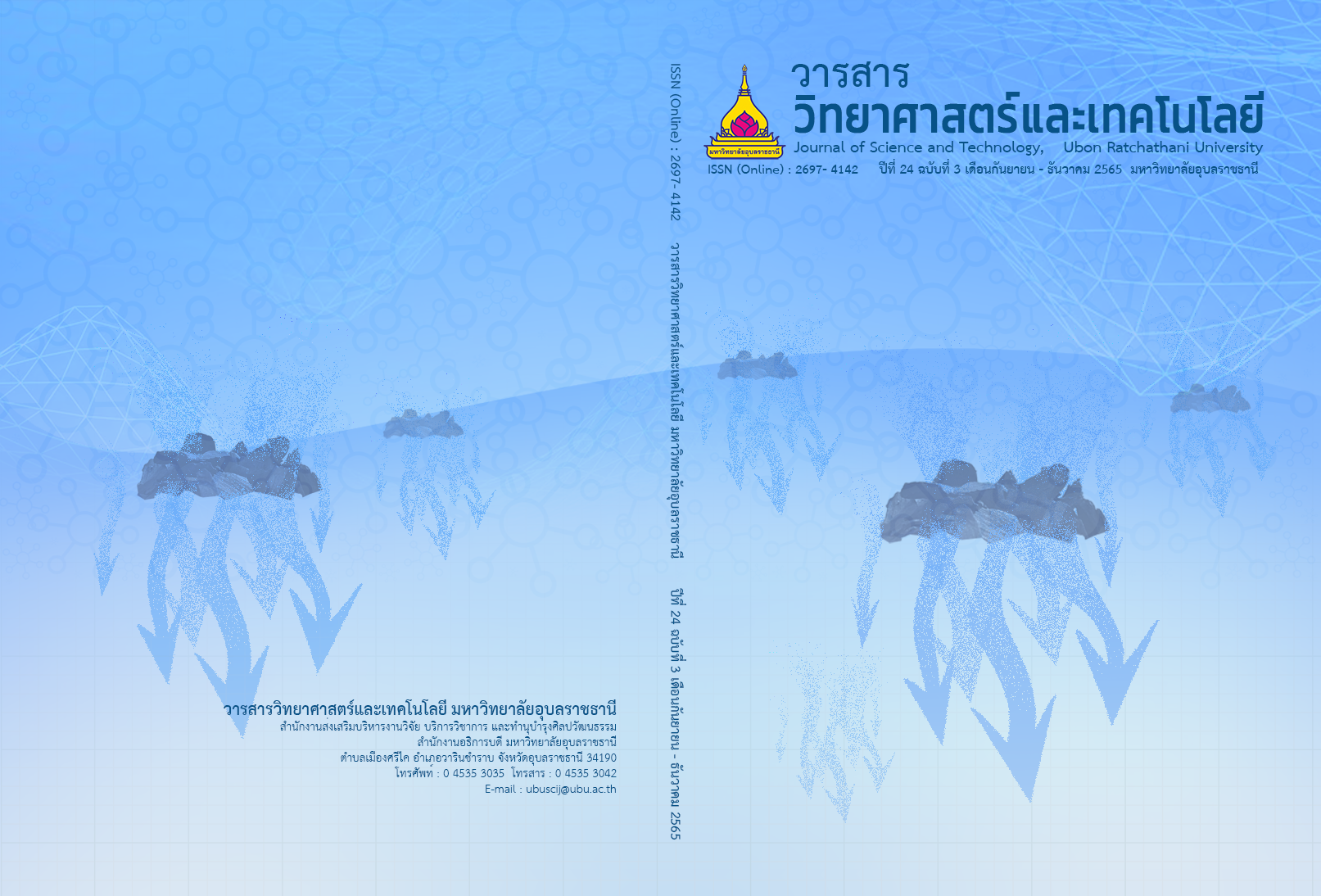ความหลากหลายทางชีวภาพและองค์ประกอบชนิดปลาในห้วยบังเลียง แขวงจำปาสัก สาธารณรัฐประชาธิปไตยประชาชนลาว
Main Article Content
บทคัดย่อ
ห้วยบังเลียงเป็นลำน้ำสาขาของแม่น้ำโขงในภาคใต้ของสาธารณรัฐประชาธิปไตยประชาชนลาว (สปป. ลาว) มีต้นน้ำอยู่บนที่ราบสูงโบโลเวนที่มีความสูงเฉลี่ย 1,200 เมตรเหนือระดับน้ำทะเล การศึกษาความหลากหลายทางชีวภาพและโครงสร้างประชากรปลาในครั้งนี้วางแผนรวบรวมข้อมูลจาก 6 สถานีสำรวจครอบคลุมบริเวณต้นน้ำ ตอนล่าง และลำน้ำสาขาของห้วยบังเลียง โดยเก็บข้อมูล 3 ช่วงเวลาในรอบปี ระหว่างปี 2563-2564 สุ่มตัวอย่างปลาด้วยเครื่องมือข่าย ขนาดช่องตาต่างกัน 6 ช่องตา คือ 1.5, 2, 4, 6, 8 และ 10 เซนติเมตร และอวนทับตลิ่ง นำข้อมูลมาวิเคราะห์ความหลากหลายทางชีวภาพ ดัชนีทางนิเวศวิทยา และลักษณะทางนิเวศวิทยาของพื้นที่สำรวจทั้ง 6 แห่ง ปลาที่ได้จากการสำรวจทั้งหมด 769 ตัว จำแนกได้อยู่ใน 18 วงศ์ และ 54 ชนิด โดยวงศ์ปลาตะเพียน (Cyprinidae) เป็นกลุ่มเด่น มีจำนวน 18 ชนิด คิดเป็นสัดส่วนร้อยละ 33.33 ของจำนวนชนิดพันธุ์ปลาที่พบทั้งหมด นอกจากนี้ยังพบปลาที่ยังไม่มีการบรรยายทางวิชาการ 3 ชนิด ได้แก่ ปลาอีดพูโอย (Lepidocephalichthys n.sp.), ปลาซิวพูโอย (Rasbora n.sp.) และปลาแป้นน้ำพาก (Parambassis n.sp.) ที่สถานีสำรวจที่ 5 และ 6 ซึ่งอยู่บริเวณต้นน้ำของห้วยบังเลียงพบปลา 14 ชนิด ใน 9 วงศ์ โดยเป็นปลาต่างถิ่น 1 ชนิด (Oreochromis niloticus) ในบริเวณสำรวจนี้พบปลาจาด (Poropuntius solitus) และปลาซิวใบไผ่ (Devario gibber) เป็นปลาชนิดหลัก ที่สถานีสำรวจที่ 1, 2 และ 4 ซึ่งอยู่บริเวณตอนล่างของห้วยบังเลียง เป็นบริเวณที่มีความหลากหลายทางชีวภาพสูง โดยพบปลา 38 ชนิด ใน 13 วงศ์ แต่ไม่พบปลาเฉพาะถิ่น ในบริเวณสำรวจนี้พบปลาสะนาก (Raiamas guttatus) และปลาขี้ยอกครีบดำ (Mystacoleucus atridorsalis) เป็นปลาชนิดหลัก
Article Details

อนุญาตภายใต้เงื่อนไข Creative Commons Attribution-NonCommercial-NoDerivatives 4.0 International License.
บทความที่ได้รับการตีพิมพ์เป็นลิขสิทธิ์ของ วารสารวิทยาศาสตร์และเทคโนโลยี มหาวิทยาลัยอุบลราชธานี
ข้อความที่ปรากฏในบทความแต่ละเรื่องในวารสารวิชาการเล่มนี้เป็นความคิดเห็นส่วนตัวของผู้เขียนแต่ละท่านไม่เกี่ยวข้องกับมหาวิทยาลัยอุบลราชธานี และคณาจารย์ท่านอื่นๆในมหาวิทยาลัยฯ แต่อย่างใด ความรับผิดชอบองค์ประกอบทั้งหมดของบทความแต่ละเรื่องเป็นของผู้เขียนแต่ละท่าน หากมีความผิดพลาดใดๆ ผู้เขียนแต่ละท่านจะรับผิดชอบบทความของตนเองแต่ผู้เดียว
เอกสารอ้างอิง
Baird, I.G. and et al. 1999. The Fishes of Southern Lao. Vientiane: Lao Community Fisheries and Dolphin Protection Project.
Rainboth, W.J., Vidthayanon, C. and Yen, M.D. 2012. Fishes of the Greater Mekong Ecosystem with Species List and Photographic Atlas. Ann Arbor: Museum of Zoology, University of Michigan.
Department of Natural Resources and Environment, Champasak Province. 2015. Pollution Report of Champasak Province. Champasak: Department of Natural Resources and Environment, Champasak Province. (in Lao)
Department of Irrigation, Pathoumphone District. 2020. Irrigation project of Banglieng Reservoir. Pathoumphone: Department of Irrigation, Pathoumphone District. (in Lao)
Department of Agriculture and Forestry, Champasak Province. 2021. Developing Plan of Department of Agriculture and Forestry, Champasak Province. Champasak: Department of Agriculture and Forestry, Champasak Province. (in Lao)
Roberts, T.R. 1998. Review of the tropical Asian cyprinid fish genus Poropuntius, with descriptions of new species and trophic morphs. Natural History Bulletin of the Siam Society. 46(1): 105-135.
Roberts, T.R. 1998. Systematic revision of the balitorid loach genus Sewellia of Vietnam and Laos, with diagnoses of four new species. Raffles Bulletin of Zoology. 46(2): 271-288.
Ng, H.H. and Kottelat, M. 2014. Clarias serniosus, a new walking catfish (Teleostei: Clariidae) from Laos. Zootaxa. 3884(5): 437-444.
Kang, D.W. and et al. 2016. Fish fauna in the Bolaven Plateau and trophic polymorphism of Poropuntius bolovenensis in Laos. Korean Journal of Environment and Ecology. 30(3): 369-375.
Kottelat, M. 2017. Schistura colossa and S. klydonion, two new species of loaches from Bolaven Plateau, southern Laos (Teleostei: Nemacheilidae). Raffles Bulletin of Zoology. 65: 341-356.
Serov, D.V. 1996. Sewellia marmorata sp. nova - new species of Homaloptera (Cypriniformes, Balitoridae) from southern Vietnam. Journal of Ichthyology. 36(2): 197-199.
Freyhof, J. 2003. Sewellia albisuera, a new balitorid loach from central Vietnam (Cypriniformes: Balitoridae). Ichthyological Exploration Freshwaters. 14(3): 225-230.
Verilino, A. and et al. 2021. Assessing volcanic hazard and exposure at obscure volcanic fields: A case study form The Bolaven volcanic field, Laos. Research Square. 1: 1-38.
Rundel, P.W. 1999. Forest Habitats and Flora in Lao PDR, Cambodia and Vietnam. Hanoi: World Wide Fund for Nature, Indochina Programme Office.
Lieng, S. 2003. Report on Monitoring of Ecological Health of the Mekong River. Phnom Penh: Phnom Penh Inland Fisheries Research and Development Institute.
Nelson, J.S. 2016. Fishes of the World. 5th edition. New York: John Wiley & Sons.
Havird, J.C. and Page, L.M. 2010. A revision of Lepidocephalichthys (Teleostei: Cobitidae) with descriptions of two new species from Thailand, Laos, Vietnam, and Myanmar. Copeia. 2010(1): 137-159.
Havird, J.C. and et al. 2010. A new species of Lepidocephalichthys (Teleostei: Cobitidae) with distinctive sexual dimorphism and comments on relationships in southern lineages of Cobitidae. Zootaxa. 2557: 1-18.
Kottelat, M. 2001. Fishes of Laos. Colombo, Sri Lanka: WHT Publications.
Praxaysombath, B. and et al. 2020. Fishes of the Mekong Basin of Laos. Vientiane: Biology Department, Faculty of Natural Sciences, National University of Laos.
Nagao Natural Environmental Foundation. 2021. Fishes of the Indochinese Mekong. Tokyo: Nagao Natural Environmental Foundation.
Clarke, K.R. and Warwick, R.M. 1994. Change in Marine Community: An Approach to Statistical Analysis and Interpretation. Plymouth: Plymouth Marine Laboratory.
Ludwig, J.A. and Renold, J.F. 1988. Statistical Ecology: A Primer on Methods and Computing. New York: John Wiley & Sons.
The IUCN Red List of Threatened Species. 2021. IUCN Red List of Threatened Species. https://www.iucnredlist.org/. Accessed 24 January 2021.
Roberts, T.R. 1995. Systematic revision of tropical Asian freshwater glass perches (Ambassidae), with descriptions of three new species. Natural History Bulletin of the Siam Society. 42: 263-290.


